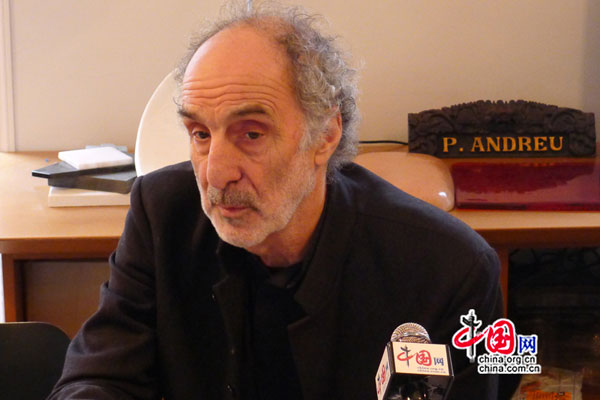Paul Andreu discusses China designs
- By Li Zhijian
 0 Comment(s)
0 Comment(s) Print
Print E-mail China.org.cn, January 28, 2014
E-mail China.org.cn, January 28, 2014
On the eve of the 50th anniversary of the establishment of diplomatic relations between China and France, French architect Paul Andreu, who contributed to the design and construction of the National Centre for the Performing Arts (NCPA), sat down for an exclusive interview with China.org.cn in his Paris office.
|
French architect Paul Andreu [Photo/China.org.cn] |
Asked about the reasons that pushed him to participate in the design of the NCPA, Andreu recalled, "I'd read that China would be holding a [design] competition for the opera house and I personally felt like doing new things in China. Not that I thought I could or would win the contest, but rather to just train myself and learn more about the country."
When I went to visit the site prior to the competition, I was caught by a slight feeling of terror, that feeling you get when facing things of authority. Indeed, it lies in the heart of Beijing. The National Art Museum of China, the Great Hall of the People and the Forbidden City, they are one by one buildings of power throughout ancient and modern history. I wanted mine to be of its time and just as strong", he emphasized.
To explain his vision on cooperation, Andreu uses a visual image, explaining, "We must cultivate our unique characteristics and rub them against each other until something appears. And at that precise moment, we may have created something new; whether it belongs to one or the other, doesn't really matter."
After completing his design of the NCPA, Andreu has undertaken several other projects across China. "I just finished a big project of opera and theatre halls in Jinan City, as well as designed a museum in Taiyuan. Of course, both are great works, but I will never again be able to design a building as good as the NCPA, nor one that is as important on a functional level," he said.
Given China's rapid economic development, some now compare the country to a global architecture lab. Yet Andreu does not share their opinion.
"I've always said this to be untrue. I think that, like myself, the vast majority of my colleagues wants to create buildings that cannot be built here because we neither have the means nor the audacity. But not because we want to go Gothic crazy and design silly things just for fun," he assured.
"At the same time," Andreu added, "Chinese architects are set to take matters into their own hands. They are well-trained; they know their things and have by now become completely autonomous. I expect they will use their independence and development to the fullest."
When I was in charge of designing airports, I did not start by literally designing the airports in China myself; I started by hiring ten Chinese interns. These interns were of a very high level. We shared absolutely wonderful business, intellectual and cultural connections."
"I always say that China, for me, was like the huge map we would have to drag from class to class in high school. On them, there was one massive yellow spot, China," Andreu ended on a humorous note.
The article was translated from the original French by Elsbeth van Paridon.







Go to Forum >>0 Comment(s)